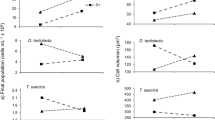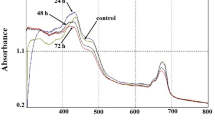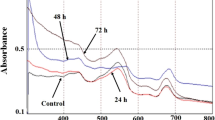Abstract
Silver nanoparticles (AgNPs) are one of the most actively used nanomaterials. Therefore, their release into the environment becomes inevitable. Consequently, studies regarding the harmful effects of AgNPs towards organisms are very common. In the process of investigating the effects of silver nanoparticles on living cells, other effects besides the toxic ones were revealed. Thus, different nanoparticles can stimulate biosynthetic processes, which will significantly expand their application in biotechnology. The aim of this paper was to elucidate the possibility of using small silver nanoparticles (10–20 nm) stabilized with polyethylene glycol and citrate as stimulators in the biotechnology of microalga Porphyridium cruentum. This red microalga is recognized as a producer of polysaccharides, proteins, polyunsaturated fatty acids. Silver nanoparticles stabilized with polyethylene glycol of 12 nm in size, as well as nanoparticles stabilized with citrate of 10 and 20 nm in size, were used in concentrations ranging from 0.01 to 1.0 μM. Concentrations were determined for each type of particles, where an increased accumulation of polysaccharides and proteins was observed in Porphyridium cruentum biomass. Moreover, the lack of toxicity of these nanoparticles was confirmed by maintaining a high level of productivity.
Access provided by Autonomous University of Puebla. Download conference paper PDF
Similar content being viewed by others
Keywords
1 Introduction
Silver nanoparticles are widely applied in various fields, such as optoelectronics, biomedicine, cosmetology, food packaging, and other fields, while the problem of their release into the environment and toxicity to living organisms is one of the most intensively studied [1]. Algae, as primary producers in the food chain, are the most commonly used organisms for assessing the toxicity of nanoparticles [2], and their toxic effects depend on shape, size, chemical composition, concentration, solubility, degree of dispersion of nanoparticles, characteristics of microalgae cell and, equally important, the environment [3].
At the same time, silver nanoparticles can stimulate different processes in the cells of microalgae and cyanobacteria [4]. For instance, polyethylene glycol-coated small-sized nanoparticles enhanced the productivity of Dunaliella salina by 15% and carotene content in biomass by 20–36% [5]. Small nanoparticles in polyethylene glycol coating were non-toxic or showed low toxicity towards cyanobacterium Arthrospira platensis grown in a closed system [6].
Porphyridium cruentum is a marine red microalga known as a producer of omega-3 polyunsaturated fatty acids and sulfated polysaccharides known to inhibit retrovirus replication [7]. Meanwhile, various substances have been proposed as stimulators of the biosynthetic processes of porphyridium -organic compounds, mineral compounds and 3d transition metal complexes [8, 9]. Porphyridium cruentum can serve as a matrix for the biosynthesis of metal nanoparticles [10]. It has also been shown that CdSe nanoparticles in concentrations of 4.0–8.0 mg/L ensured an increase in the amount of biomass by 18.4–47%. This stimulating effect can probably be explained by the formation of a hybrid NP-phycoerythrin system, which captured very efficient light energy [11].
In this paper, we aimed to elucidate the possibility of applying small silver nanoparticles (10–20 nm) as stimulators in the biotechnology of microalga Porphyridium cruentum.
2 Material and Methods
In this study, 12 nm silver nanoparticles stabilized with polyethylene glycol (AgNP(PEG)) manufactured by M9 Company (Tolyatti, Russia), and 10 and 20 nm stabilized with citrate (AgNP(CYT)) (Sigma) were used. The strain Porphyridium cruentum CNMN-AR-01 grown on Brody's nutrient medium was used. The cultivation conditions were as follows: the quantity of inoculums - 0.55–0.6 g/L absolutely dry biomass (ADB); temperature of 25–28\(^\circ {\text{C}}\) , pH of the medium 6.8–7.2, and continuous illumination of 50–57 μmol photons m–2 s–1. Cultivation was carried out in 100 ml Erlenmeyer flasks with a working volume of 50 ml. The cultivation cycle lasted 14 days.
The quantity of biomass was determined by recording the absorbance of the cell suspension at a wavelength of 565 nm, and the quantitative calculation was based on the calibration curve. Estimation of carbohydrate content in algal biomass was determined by the Anthrone method [12], and protein content – by the Lowry method [13].
3 Results and Discussions
Silver nanoparticles were added in concentrations between 0.01 and 1.0 μM prior to the inoculum was added. Microalgal cells were in contact with nanoparticles throughout the entire cultivation cycle. At the end, the biomass was collected, its quantity and the content of proteins and carbohydrates were determined. The amount of biomass varied in the experimental samples within ranges very close to control samples (Fig. 1).
An increase of 10–11% was found for concentrations of 0.01, 0.025 and 0.25 μM AgNP(PEG) and 0.25 μM AgNP(CYT) of 10 nm in size. When applying 20 nm AgNP(CYT) in concentration of 0.5 μM, a slight decrease in the amount of Porphyridium cruentum biomass was observed. There was no significant dependence of this response on the concentration and size of nanoparticles. In addition, the stabilizer did not appear to alter the culture response either.
Organic or bioorganic stabilizing compounds used to coat the metal cores of nanoparticles can affect cultures of microalgae and cyanobacteria in different ways [14]. Some authors argued that stabilizers reduce toxicity, while others showed reverse effects. For instance, the toxicity of 5 nm AgNPs stabilized with poly(N-vinyl-2-pyrrolidone)/ polyethyleneimine (PVP/PEI) towards microalga Phaeodactylum tricornutum exceeded the toxicity of large nanoparticles - 47 nm without a coating. It is assumed that shell components are involved in the formation of small conglomerates with a higher affinity for the algal cell membrane [14, 15].
For the most part, studies of the effects of nanoparticles on aquatic microorganisms aim to identify their toxic effects. The contact of AgNPs 2 nm and 15 nm in size at concentrations of 10–300 μg/L with microalgae Chlamydomonas reinhardtii and Phaeodactylum tricornutum led to a sharp decrease in the amount of biomass [16]. At the same time, silver nanoparticles are less toxic than ions [17].
Recently, there have been reports upon the stimulatory effect of silver nanoparticles on microalgae. For example, 10–150 μg/L of 30–50 nm AgNPs enhanced the growth of microalgae Phaeodactylum tricornutum [16]. Silver nanoparticles 12 nm in size in a polyethylene glycol coating in concentrations from 0.025 to 0.5 μM favoured the growth of Spirulina platensis biomass by 24–36% [6].
AgNP(PEG) added to the mineral medium in concentrations of 0.054–0.108 mg/L stimulated the accumulation of Dunaliella salina biomass by 12–33% [5], and for other AgNPs at the same concentrations, the inhibitory effect of D. salina growth was found [18]. At the same time, quite high concentrations of AgNPs used in the cultivation of Chlamydomonas reinhardtii (10–300 μg/L) for 24 h did not alter the cell density [16].
In this study, silver nanoparticles stabilized with polyethylene glycol in concentrations of 0.01–0.25 μM enhanced the growth of P. cruentum, while in the concentration range of 0.01–1.0 μM, there was a tendency toward a decrease in the amount of biomass. In the case of citrate-stabilized nanoparticles, no specific pattern of action was revealed, but it can be argued that silver nanoparticles in the tested concentrations were not toxic to P. cruentum culture. One of the responses of porphyridium culture to stress was accelerated synthesis and accumulation of carbohydrates in biomass. Starting from the biological role of sulfated polysaccharides, which constitute an important fraction of carbohydrates, and the fact that P. cruentum is grown on an industrial scale to obtain these substances, this parameter was determined in the resulting biomass (Fig. 2).
Concentrations of AgNP(PEG) that stimulated biomass production also resulted in an increase in carbohydrate content by more than 30%.
For a concentration of 0.25 μM AgNP(CYT) of 10 nm in size, there was recorded a 20% increase in carbohydrate content. The carbohydrate content also increased by 20% in biomass obtained in the presence of 0.01 and 0.05 μM AgNP(CYT) of 20 nm. Thus, studied silver nanoparticles stimulated the accumulation of carbohydrates in biomass, and the effect depended on the concentration.
Carbohydrates are the main photosynthetic products that make up the carbon supply. The increase in carbohydrate production may be associated with a defense mechanism in response to stress caused by changes in environmental conditions. The protective action of carbohydrates against oxidative stress is based on the annihilation of reactive oxygen species. An increase in carbohydrate content by 20, 22 and 80% was established for concentrations of 360, 720 and 1440 μg/L AgNPs with a size of 140 nm upon 24-h contact with green microalga Chlorella vulgaris. It is assumed that the culture response was caused by severe stress, since the applied concentrations significantly reduced the number of algal cells [19].
At the same time, when microalga Skeletonema costatum was exposed to oleyamine-capped 10 nm AgNPs in concentrations from 0.05 to 5.0 mg/L, no changes in the carbohydrate content were observed, while the stress intensity was very high [20]. Thus, in some cases, this may be evidence for the involvement of nanoparticles in cellular biosynthetic activity with a stimulating effect that does not necessarily lead to oxidative stress in the cell. In the case of cultivation of microalga Porphyridium cruentum in the presence of low concentrations of AgNPs, a stimulatory effect can be revealed, which led to an increase in the carbohydrate content. An obvious stimulatory effect was determined for silver nanoparticles stabilized with polyethylene glycol.
Protein content is one of the most important biochemical parameters characterizing the biomass quality. In most experimental variants, the amount of proteins in porphyridium biomass was at the control level (Fig. 2). The concentrations were determined for all types of used nanoparticles, which acted as stimulators of protein accumulation in biomass. Thus, for AgNPs(PEG), a concentration of 0.5 μM was established, which increased the protein content by 39%. The same concentration of AgNP(CYT) of 10 nm provided an increase in the amount of proteins by 42%, and AgNP(CYT) of 20 nm in size - by 14%. The nanoparticle concentrations of 0.01–0.025 μM and 1.0 μM did not change the protein content in biomass.
In the presence of 0.5 μM AgNPs, carbohydrate content in P. cruentum biomass was below the limit of control values, which indicated their intensive consumption. Some authors suggest that protein accumulation in the presence of low concentrations of silver nanoparticles as a result of the activation of detoxification mechanisms. This strategy may be one of the ways in which algae can eliminate the toxic effects of metals, using carbohydrates in favour of protein accumulation [21, 22]. Silver is known to have an affinity for sulfur, resulting in an increase in the content of sulfated polysaccharides and sulfur-containing amino acids [23]. The increase in the amount of proteins in microalgal biomass under the action of AgNPs has been observed by other authors. Thus, microalga Chlorella vulgaris, exposed to AgNPs concentrations of 90–720 μg/L, accumulated 110–293% more protein than the control sample [19].
It is worth mentioning that the stimulatory effect of AgNPs was recorded due to the contact of nanomaterials with microalgal cells during the cultivation, and not during a short-term contact, as in most published studies. Maintaining algal productivity at an acceptable level indicated the lack of a toxic effect of the studied nanoparticles within the limits of the applied concentrations. Consequently, this makes it possible to develop technologies for the cultivation of microalga P. cruentum, in which nanoparticles act as stimulators that ensure the directed accumulation of certain compounds in biomass.
The concentration of nanoparticles was the main factor that determined changes in the biochemical composition of microalga as a result of the activation of mechanisms for the accumulation of carbon reserves or the use of these reserves for other groups of substances, for example, proteins. Therefore, screening the doses of nanoparticles can reveal the optimal concentrations for directing biosynthetic processes in microalgae in order to obtain biomass with a programmed biochemical composition.
4 Conclusions
Silver nanoparticles coated with polyethylene glycol and citrate 10–20 nm in size at certain concentrations can stimulate some biosynthetic processes in red microalga Porphyridium cruentum, which can serve as a basis for their use in biotechnology.
Silver nanoparticles stabilized with polyethylene glycol at concentrations of 0.01–0.25 μM stimulated the accumulation of biomass and increase polysaccharide content by more than 30%.
Silver nanoparticles stabilized with citrate, 10 and 20 nm in size, at a concentration of 0.01 and 0.05 μM, also increased the carbohydrate content by 20% compared to control sample.
It was found that the concentration of 0.5 μM for all types of studied nanoparticles had a stimulating effect on the accumulation of proteins in Porphyridium cruentum biomass. In the case of silver nanoparticles coated with polyethylene glycol, the protein content in algal biomass increased by 39%, in the case of AgNP (CYT) 10 nm - by 42%, and AgNP (CYT) 20 nm - by 14%.
The concentration of nanoparticles was the main factor determining changes in the biochemical composition of microalgae due to the activation of mechanisms for accumulating carbon reserves or using these reserves for other groups of substances, for example, proteins.
References
Rudramurthy, G.R., Swamy, M.K.: Potential applications of engineered nanoparticles in medicine and biology: an update. J. Biol. Inorg Chem. 23, 1185–1204 (2018)
Wang, F., Guan, W., Xu, L., et al.: Effects of nanoparticles on algae: adsorption, distribution ecotoxicity and fate. Appl. Sci. 9, 1534 (2019)
Bundschuh, M., Seitz, F., Rosenfeldt, R.R., et al.: Effects of nanoparticles in fresh waters: risks, mechanisms and interactions. Freshwater Biol. 61, 2185–2196 (2016)
Vargas-Estrada, L., Torres-Arellano, S., Longoria, A., et al.: Role of nanoparticles on microalgal cultivation: a review. Fuel 280, 118598 (2020). https://doi.org/10.1016/j.fuel.2020.118598
Maftei, E., Rudic, V.: The use of gold and silver nanoparticles in cultivation of microalga Dunaliella salina. Buletinul AŞM. Ştiinţele vieţii 3(336), 159–165 (2018)
Cepoi, L., Zinicovscaia, I., Rudi, L., et al.: Effect of PEG-coated silver and gold nanoparticles on spirulina platensis biomass during its growth in a closed system. Coatings 10, 717 (2020). https://doi.org/10.3390/coatings10080717
Lutzu, G.A., Zgang, L., Zgang, Z., et al.: Feasibility of attached cultivation for polysacharides production by Porphyridium cruentum. Bioprocess Biosyst. Eng. 40, 73–83 (2017)
Coropceanu, E., Rudic, V., Cepoi, L., et al.: Synthesis and cristal structure of [Co(DmgH)2(Thio)2]2F[PF6]. The effect of fluorine-containing Co(III) dioximates on the physiological proceses of themicroalga porphyridium cruentum. Russ. J. Coord. Chem. 45, 200–207 (2019)
Lu, X., Nan, F., Feng, J., et al.: Effects of different environmental factors on the growth and bioactive substance accumulation of porphyridium purpureum. Int. J. Environ. Res. Public Health 17(7), 2221 (2020)
Cepoi, L., Rudi, L., Zinicovscaia, I., et al.: Biocemical changes in microalga porphyridium cruentum associated with silver nanoparticles biosynthesis. Arch. Microbiol. 203, 1547–1554 (2021)
Rudic, V., Cepoi, L., Gutsul, T., et al.: Red algae porphyridium cruentum growth stimulated by CdSe Qantum Dots covered with thioglycerol. J. Nanoelectron. Optoelectron. 7(7), 681–687 (2012)
Hedge, J., Hofreiter, B.: Methods of Estimating Starch and Carbohydrates, Carbohydrate Chemistry, pp. 163–201. Academic Press, New York, NY. (1962)
Lowry, O., et al.: Protein measurement with the folin phenol reagent. J. Biol. Chem. 193(1), 265–275 (1951)
Tsiola, A., Pitta, P., Callol, A.J., et al.: The impact of silver nanoparticles on marine plankton dynamics: dependence on coating, size and concentration. Sci. Total Environ. 601–602, 1838–1848 (2017)
Schiavo, S., Duroudier, N., Bilbao, E., et al.: Effects of PVP/PEI coated and uncoated silver NPs and PVP/PEI coating agent on three species of marine microalgae. Sci. Total Environ. 577, 45–53 (2016)
Sendra, M., Yeste, M.P., Gatica, J.M.: Direct and indirect effects of silver nanoparticles on freshwater and marine microalgae (Chlamydomonas reinhardtii and Phaeodactylum tricornutum). Chemosphere 179, 279–289 (2017)
Di, H., Dorantes-Aranda, J.J., Waite, T.D.: Silver nanoparticle algae interactions: oxidative dissolution, reactive oxygen species generation and synergistic toxic effects. Environ. Sci. Technol. 46, 8731–8738 (2012)
Johari, S.A., Sarkheil, M., Tayemeh, M.B., et al.: Influence of salinity on the toxicity of silver nanoparticles (AgNPs) and silver nitrate (AgNO3) in halophilic microalgae Dunaliella salina. Chemosphere 209, 156–162 (2018)
Romero, N., et al.: Physiological and morphological responses of green microalgae Chlorella vulgaris to silver nanoparticles. Environ. Res. 189, 109857 (2020)
Huang, J., Cheng, J., Yi, J.: Impact of silver nanoparticles on marine diatom Skeletonema costatum: Silver nanoparticles are phototoxic to marine diatom. J. Appl. Toxicol. 36, 1343–1354 (2016)
Marchello, A.E., Barreto, D.M., Lombardi, A.T.: Effects of titanium dioxide nanoparticles in different metabolic pathways in the freshwater microalgae Chlorella sorokiniana (Trebouxiophyceae). Water Air Soil Pollut. 229(48) (2018). https://doi.org/10.1007/s11270-018-3705-5
Miao, A.J., Schwehr, K.A., Xu, C., et al.: The algal toxicity of silver engineered nanoparticles and detoxification by exopolymeric substances. Environ. Pollut. 157, 3034–3041 (2009)
McShan, D., Ray, P.C., Yu, H.: Molecular toxicity mechanism of nanosilver. J. Food Drug Anal. 22(1), 116–127 (2014)
Acknowlegment
The results were obtained within the project 20.80009.5007.05, NARD, Republic of Moldova.
Funding
The authors declare that they have no conflict of interest.
Author information
Authors and Affiliations
Editor information
Editors and Affiliations
Rights and permissions
Copyright information
© 2022 The Author(s), under exclusive license to Springer Nature Switzerland AG
About this paper
Cite this paper
Cepoi, L. et al. (2022). Silver Nanoparticles as Stimulators in Biotechnology of Porphyridium cruentum. In: Tiginyanu, I., Sontea, V., Railean, S. (eds) 5th International Conference on Nanotechnologies and Biomedical Engineering. ICNBME 2021. IFMBE Proceedings, vol 87. Springer, Cham. https://doi.org/10.1007/978-3-030-92328-0_68
Download citation
DOI: https://doi.org/10.1007/978-3-030-92328-0_68
Published:
Publisher Name: Springer, Cham
Print ISBN: 978-3-030-92327-3
Online ISBN: 978-3-030-92328-0
eBook Packages: EngineeringEngineering (R0)






